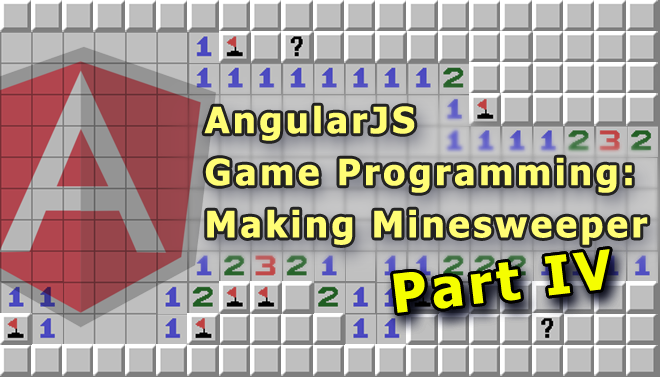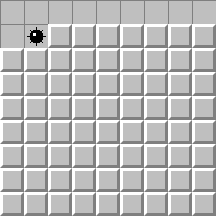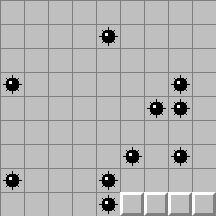
Last time on “AngularJS Game Programming”: We added graphics to a basic working minefield that allows you to uncover blocks. In this post we’re going to add mines!
Adding Mines
Ok, now we’re ready to add mines to the minefield. First let’s write the code to place a single random mine. Let’s start by calculating the row and column where the mine will be placed:
var row = Math.round(Math.random() * 8); var column = Math.round(Math.random() * 8);
Then we need a way to retrieve information about that spot so that we can indicate there’s a mine there:
function getSpot(minefield, row, column) {
return minefield.rows[row].spots[column];
}
Now we need a way to store that information somehow. Let’s create a property in the spot and set it to either “empty” or “mine”. Our mine placing function should look like this:
function placeRandomMine(minefield) {
var row = Math.round(Math.random() * 8);
var column = Math.round(Math.random() * 8);
var spot = getSpot(minefield, row, column);
spot.content = "mine";
}
Now we need to update the createMinefield() function so that it initially sets content to “empty”.
var spot = {};
spot.isCovered = true;
spot.content = "empty"; // new
row.spots.push(spot);
Now we need a way to display it. The spot should look empty if content is set to “empty” and isCovered is false. You should see a mine if isCovered is set to false and content is set to “mine”.
Your td should now look like this:
<td ng-repeat="spot in row.spots" ng-click="spot.isCovered = false">
<img ng-if="spot.isCovered" src="block.png">
<img ng-if="!spot.isCovered && spot.content == 'empty'" src="empty.png">
<img ng-if="!spot.isCovered && spot.content == 'mine'" src="mine.png">
</td>
Let’s do a quick test by placing one mine in the minefield. Update the createMinefield() to call placeRandomMine(). Then click to uncover the blocks until you find it – it might take a while:

Play with it at: http://jsfiddle.net/luisperezphd/Ap8Xp/
More Mines
Let’s add a function to place more mines. Name it placeManyRandomMines() and have it call placeRandomMine() 10 times:
function placeManyRandomMines(minefield) {
for(var i = 0; i < 10; i++) {
placeRandomMine(minefield);
}
}
Update createMinefield() to call this function instead of the previous one that only places one mine. Again test it by clicking on the blocks until you uncover several mines:

Play with it at: http://jsfiddle.net/luisperezphd/V5pwz/
Next Time
In the next post we’re going to add numbers and get one step closer to the full game.
Next Post: Adding Numbers
Very helpful guide for someone like me who is trying to learn angular. I’m looking forward to the next parts.
One thing to note. In the loop for creating the 10 random locations, the same location can be picked more than once, leading to less than 10 locations with mines. If I am thinking about it properly, with 9*9 locations, the probability of at least one clash (i.e. picking the same location more than once) with 10 tries is:
1 – (81x80x79x78x77x76x75x74x73x72)/81^10 = 0.439..
So just under half the time there will be less than 10 mines.
Maybe the easiest solution to this is to have a while loop inside the
placeRandomMine()that loops until an empty spot is found. I forked your last fiddle and tried this and it seems to work and we always get 10 unique locations.http://jsfiddle.net/6rhUh/5/
Great point mark. Thanks for pointing that out.
I’ve been following along, and I solve that with a bogosearch – https://github.com/DavidSouther/ng-minesweeper/blob/gh-pages/minefield.js#L83